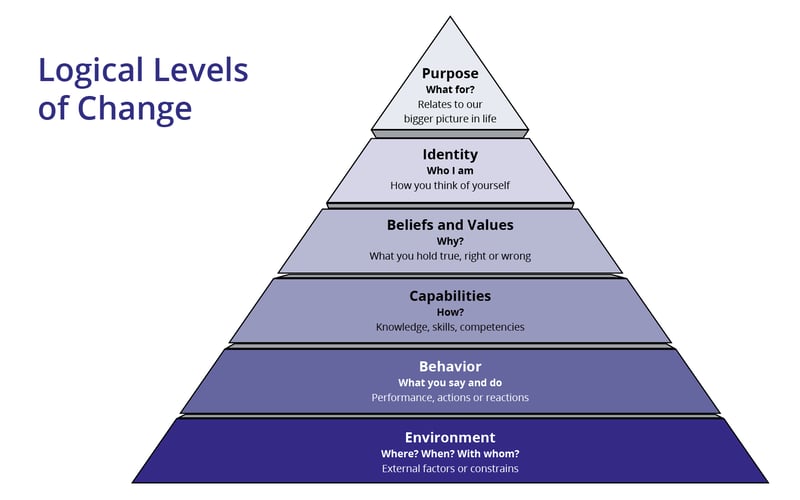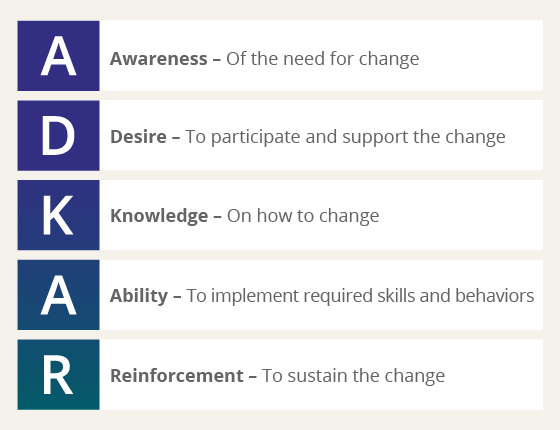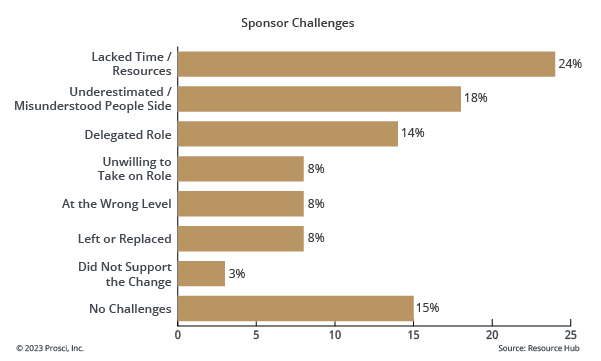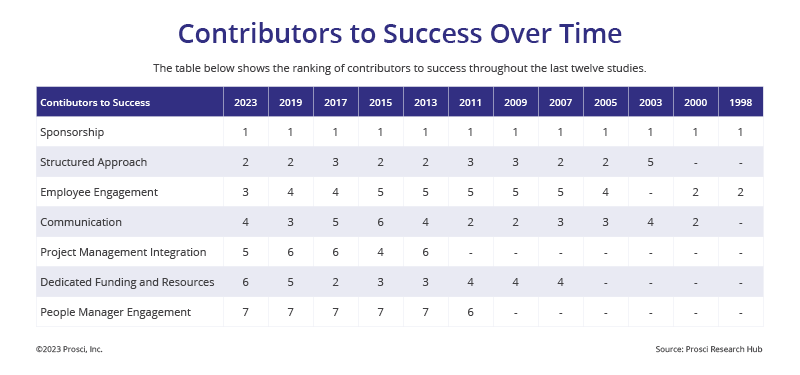You have no items in your shopping cart.
Build Sponsor Desire for Change Management by Tapping Into Beliefs
.png)
5 Mins
Updated: October 31, 2024
Published: December 19, 2023

Change practitioners often tell us they struggle with building Desire in sponsors. It’s a common challenge cited in our research. But you can tap into sponsor beliefs to help them build Desire to participate and support a change. Here’s how.
Neuro-linguistic Programming (NLP) is useful when applied in change management because it helps you become a better listener and communicator. By understanding people’s belief systems, you can present information about a change in a way that aligns with the way they think. It may sound manipulative, but your goal is simply to listen, observe, and try to understand people better, so you can help them move through their ADKAR barriers and be successful during change.
Neurological Levels Overview
All people have belief systems. They’re part of the Neurological Levels framework created by Robert Dilts, which help you understand how people view and interpret situations. The levels appear in a pyramid or hierarchy, with each level impacting and relating to those below it.

- The top level is Purpose or Spirituality, but some people don’t know their life’s purpose or feel spiritual, so it’s an optional level. If you do have purpose or spirituality, it informs your identity, which is in the next layer of the hierarchy.
- Everyone has an Identity that represents who they think they are. If I ask you who you are, you'll respond quickly with a description of the things that are important to you, such as your name, job title, family role and key interests.
- Your Identity creates your Beliefs and Values. These are your life experiences. Your upbringing and journey so far create certain views and principles that you live by.
- Those values and beliefs give you the Capabilities either to do something or not do something. An empowering belief gives you the capability to do it. A disempowering belief stops you being able to demonstrate that capability.
- You exhibit the capabilities in the form of Behaviors. These behaviors are how you act, react and go about carrying out your life in the world.
- Behaviors create the Environment around you. Think of this like an aura you create around yourself. A consequence of your behaviors, this environment can be positive or negative.
How does this apply to change management sponsorship? During an organizational change, a person will say, “I (identity) can (the belief and value) do (the capability) X (the behavior you want me to exhibit) here (the environment it needs to happen in). This translates into “I can do X here” or “I cannot do X here” as you come down the triangle, and the can or cannot is determined by the beliefs you have around yourself.
ADKAR and the Logical Levels of Change
Now, let’s consider how aspects of this framework align with the ADKAR Model and how it can help you build Desire for change in change management sponsors and others. Note that we typically avoid starting with Purpose or Spirituality because it is dodgy in an organizational setting. Instead, we start with Identity:
- Identity aligns with Awareness. This is the level you need to achieve first for meaningful change to take place. “I have the need to change.”
- Beliefs and Values align with Desire to participate and support the change. “I have the belief that I need to change.”
- Capabilities aligns with Knowledge of how to change. “I know how to change or have the capability to learn how to.”
- Behavior aligns with the Ability to demonstrate the desired skills and behaviors. “I have the skills to demonstrate changed behaviors.”

So, when you work to build Desire to participate and support a change, people must first believe that it’s right for them. If they don’t, they will experience a barrier to the change at Desire.
Here’s a basic example to illustrate:
Your partner wants you to play golf with them, but your past experiences with golf have not been enjoyable. To motivate you to play, your partner buys you a set of clubs. They show you how to hold and swing the driver. They give you lessons with best golf pro in town, too. But you may never learn to play or demonstrate the right behaviors because deep down, your belief is that, golf is a waste of your time.
The same thing happens during organizational changes with people who must change the way they do their jobs every day. Without the right beliefs, they won’t have the Desire they need before they can start building Knowledge and then Ability. They get stuck at Desire.
This also happens when executives and senior leaders don’t have the Desire to fulfill their critical role as sponsors in change management.
Building Desire in
Change Management Sponsors
Prosci Best Practices in Change Management research reveals several common sponsor challenges, some of which are directly related to Desire to participate and support the change:
To build Desire in sponsors, you must first uncover their beliefs about the change, so you can help them reposition or adopt a new mindset. Ask them to tell you what’s going on, what’s happening, and then listen actively. Once you uncover their belief systems and what they're based upon, you need to discern whether those beliefs are based on facts or assumptions they have made.
For example:
You: “Tell me about the project you're sponsoring. What’s going on?”
Sponsor: “Oh, well, it's big. It's really complex. We're bringing an ERP. It isn’t going to be popular. It’s going to be a tough battle to win and a lot of work.”
That's a negative belief system around what they're trying to achieve, which is going to impact their capability to be a good sponsor. The disempowering belief is going to come across as timid behavior when they're talking about the change to the organization. They’re not convinced, therefore they are not able to be convincing. They don’t have the correct level of Desire to be an effective sponsor.
But if you work with the sponsor to identify the initiative’s success criteria and help them appreciate the value to the organization, its people and how that aligns with their own Values and Beliefs. it can help a sponsor change their belief system about what they're doing. This then makes the effort and investment worthwhile for them.
They move from “I cannot be a good sponsor for the ERP system implementation” to “I can be a good sponsor for the ERP system implementation.”
Now the sponsor has the capability to be an active and visible sponsor in a convincing way. Now they want to be the sponsor. They believe it’s the right thing to do. They have achieved Desire and are willing to acquire the Knowledge and Ability needed to be a successful sponsor during change.

Sponsorship has been cited as the #1 contributor to successful change for 25 years.
Help Change Management Sponsors
Overcome ADKAR Barriers
Sponsors get stuck at Desire for several common reasons. They may have had a prior experience as an unsuccessful sponsor. They might feel they are at the wrong level and lack the authority they need. Some are asked to sponsor changes without having been involved in the business case, so they lack ownership. Others simply don’t understand what a sponsor is supposed to do, or they believe they don’t have the time.
Building Desire in a sponsor who doesn’t believe in the change itself is a bit more challenging because you need to understand and address their objections. In such a case, you may ultimately appeal to the sponsor’s loyalty and duty as a leader in the organization. The sponsor can have robust debates with other leaders, but if the change moves ahead, they need to support the decision because it’s their job to be a cohesive leadership team.
If a sponsor can’t overcome their lack of Desire, they may not be the right sponsor. They will come across as negative, unsupportive, timid. They will make unconvincing arguments. It may be cliché’, but a timid request invites refusal. You've got to be convinced to be convincing.
In the Prosci Methodology, the most important behavior of sponsors is to be active and visible. They've got to believe that is the right thing to do. That belief drives the capability for them to stand up at a town hall and deliver a convincing argument and business case for the change.
Resolve Sponsor Barriers to Desire
in Change Management
Not all barriers to Desire are due to belief and values. Some are due to a true lack of capability to perform the role of a sponsor. If you face these circumstances, the best move may be to work with the leadership team to find a more effective sponsor. But in many cases, sponsors only need the right conversations to get unstuck and move forward in their ADKAR journeys. A change practitioner who actively listens and works to understand a person’s beliefs around sponsorship can help sponsors be successful in their roles and with the changes they support.

